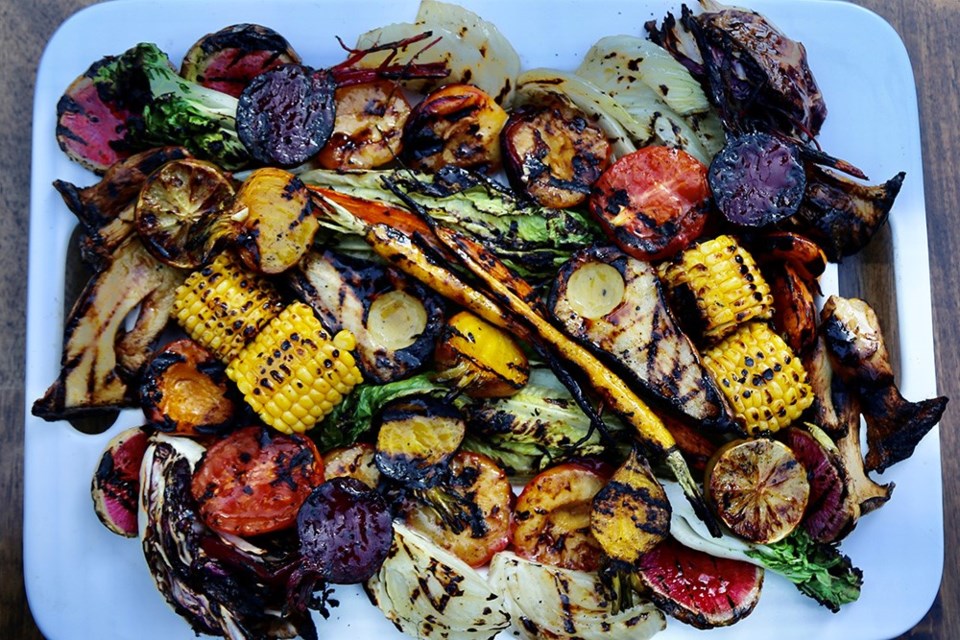If you can grow it, or buy it in the fresh produce section, chances are you can grill it. Grilling or roasting vegetables is a great way to multi-purpose surplus vegetable harvests, even those that are slightly past their prime. We are coming into a busy harvest season for home gardeners, so plan ahead to get grilling.
To use heat resources efficiently, and to get the highest possible return on my prep time investment, I tend to grill and roast in bulk. We use the proceeds for several different meals and roll-over menus, and then slice and freeze the left-overs.
‘Roll-overs’ are what we call meals made with purposeful leftovers, that is when I make more than I need for one meal, on purpose. We raised three busy children, had busy careers, and plenty of dinners guests and parties going on all at the same time, so anything I could do to put delicious and inexpensive food on the table, and spend less time and money buying groceries, became habit.
When the weather is too cold for grilling, I oven-roast and broil, sometimes using a ridged stovetop griddle to add grill marks.
There are a few simple tips and tricks to ensure success. First, dense vegetables, unless sliced very thin before grilling, generally require steaming, boiling or blanching in advance. Unlike animal protein, produce has no fat to keep it from drying out on or under heat, so I cook potatoes, beets, large radishes, thick slices of cauliflower and fennel, large carrots, etc., until just shy of al dente, before drying, slicing (or halving) and grilling. I sometimes roast vegetables whole in the oven, covered or foil-wrapped of course, but I consider that another subject entirely.
There are two schools of thought about oiling produce before grilling, and I stand firmly in the ‘yes’ camp because adding a thin coating of healthy olive oil or avocado oil helps distribute heat evenly, shortens cooking time, and helps retain moisture. I also add acid in the form of lemon juice or white balsamic vinegar, plus a pinch of salt. In a jam or in a campsite, I’ve used bottled salad vinaigrette to excellent affect. One can toss the whole works in a bowl of basting vinaigrette, or brush it on each piece of produce as it goes on the grill. Either way, save the surplus to drizzle overtop of everything when you are done.
Last night I grilled a large batch of fruit and vegetables as a feature combination appetizer/salad/main vegetable/main starch for a special meal, knowing that I would have leftovers to use in hummus, lamb (also leftover) and grilled fruit and veg wraps for my son’s lunch, and also still have enough left over to add a sophisticated layer to a simple tomato and garlic fusilli al ferretto on Sunday.
Admittedly, I don’t super-clean char from the grills as well as I could, so there is a lovely extra char on most things. If you prefer no char, then for sure clean the grill really well in advance. Also, use a heatproof silicone brush to add a skim coat of oil to the grill, to help prevent sticking. I use reusable pierced foil grilling trays and stainless steel grilling baskets for small items like shishito peppers, shiitake mushrooms, beans and snap peas.
Cut stone fruits are awesome grilled, as are pears. I sometimes add honey, pomegranate or date molasses (Persian market) to the vinaigrette. My family has two grilled fruit favourites: pears with olive oil, honey, lemon, black pepper; peaches with olive oil, pomegranate or brown sugar, and balsamic. Adding any type of sugar to the mix will create flare-ups and the fruit can burn, so turn the heat down to low. Otherwise, medium heat works just fine for most items.
This year, for research purposes, I planted several varieties of paste tomatoes. My advance plan is to halve and grill them, and then hot-water-can them as I normally do with San Marzanoes. During winter then, when the raised beds are covered in snow, I can revisit my garden over fire-roasted tomato pappardelle.
Laura Marie Neubert is a West Vancouver-based urban permaculture designer. Follow her on Instagram @upfrontandbeautiful, learn more about permaculture by visiting her Upfront & Beautiful website or email your questions to her here.
For a taste of permaculture, click on the YouTube link below:




